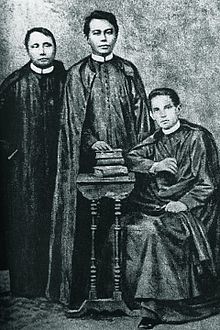Mariano Gómes | |
|---|---|
 An engraving imagining Gomes (center), the leader, with him are mestizo Jacinto Zamora on the left, and mestizo José Burgos seated on the right. | |
| Church | Catholic Church |
| Personal details | |
| Born | Mariano Gómez y Custodio August 2, 1799 |
| Died | February 17, 1872 (aged 72) Bagumbayan, Manila, Captaincy General of the Philippines, Spanish Empire |
| Nationality | Filipino |
| Denomination | Roman Catholic |
| Parents | Francisco Gómez Martina Gómez (née Custodio) |
Mariano Gómes de los Ángeles[1] (Spanish: [ˈmaˈɾjano ˈɣomes]; August 2, 1799 – February 17, 1872), often known by his birth name Mariano Gómez y Custodio or Mariano Gomez in modern orthography,[2] was a Filipino Catholic priest who was falsely accused of mutiny by the Spanish colonial authorities in the Philippines in the 19th century. He was placed in a mock trial and summarily executed in Manila along with two other clergymen collectively known as the Gomburza. Gomez was the oldest of the three priests and spent his life writing about abuses against Filipino priests.
Gomes was born on August 2, 1799, in the suburb of Santa Cruz, Manila. He was a tornatrás, one born of mixed Austronesian, Chinese and Spanish ancestries. His parents were Alejandro Francisco Gómez and Martina Custodio. After studying in the Colegio de San Juan de Letrán, he took theology in the University of Santo Tomás. He was a student preparing for the priesthood in the Seminary of Manila.
He was also the uncle of ilustrado nationalist and labor leader Dominador Gómez.[3]
On June 2, 1824, he was designated as the head priest of Bacoor, Cavite. Aside from taking care of the spiritual necessities of the town and the church, he also taught agriculture and cottage industries.[citation needed] Gomes also helped in maintaining a harmonious relationship among his other priests. He fought for equal rights for native priests against the abuses of their Spanish counterparts.
When Gomes took up parochial work, he discovered that he shared the name "Mariano Gómez" with a Spanish friar in Cavite and a priest from Cabuyao, Laguna. So he changed his last name from Gómez to Gómes, with the change from the letter "z" to the letter "s" meant to reflect his being Tagalista, meaning he was proficient in the Tagalog language. He also appended the honorific "de los Ángeles" ("of the Angels") to his surname.[2]
As such, his name formally became "Mariano Gómes de los Ángeles," and he signed his name "Mar Gómes de los Ángeles." This was the name he officially signed in his last will and testament.[1]
Gomes was accused of treason, sedition, and taking active part in the Cavite mutiny of 1872 and sentenced to death by garrote in a military court. He was sent to jail along with Joaquín Pardo de Tavera, Máximo Paterno, and the friars José Burgos and Jacinto Zamora. The three friars were executed on February 17, 1872, at Bagumbayan field; and have been known since then by the acronym composed of their collective surnames – Gomburza.
Before his death, Gomes was active in the publication of the newspaper La Verdad (Spanish: "The Truth"). At the age of 72, he was the oldest of the three priests.
With his parochial assignment, Fr. Gomes moved to Cavite Province together with his siblings and mother. He had one brother, José, and sisters, Paula and Maria Dolores. José Gómez settled in Bacoor [4], while Maria Dolores was known to have married José Trias of San Francisco de Malabon (now General Trias, Cavite)[5]. His brother José was the father of Padre Feliciano Gómez[6], a fellow secular priest who was recorded to have been arrested with him in 1872 [1]. He had another priest-nephew, Padre Manuel Trias, through his sister, Maria Dolores. Fr. Trias was the celebrant of the Mass in San Francisco de Malabon on June 12, 1898 when the Marcha Nacional Filipina was first played publicly as the elevation hymn, replacing the Spanish Marcha Real. According to Fr. Gómes' last will, he also revealed that he had a son prior to his ordination named Modesto De La Torre, who was known until then as his nephew [1].
Fr. Gomes' family ties in the province would later connect him by blood to other prominent Caviteños. Two of these, Gen. Mariano Trias (1868-1914), the 1st Vice President of the Philippines, and Rafael F. Trias, former Governor of Cavite, were the direct grandson and great-grandson of his sister Maria Dolores. As for his beloved town, he would eventually be related to Mayor Pablo Gomez Sarino (1911-1987), the longest serving mayor of Bacoor, who was the direct great-grandson of his brother José [7].